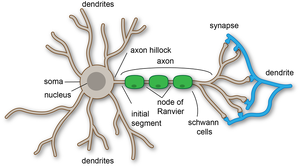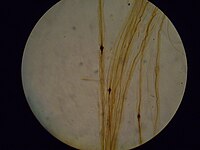Axon
The axon is the long projection of a nerve that can reach a length of tenths of centimeters, that conveys electrical impulses from the dendrites/soma of the neuron to the next neuron. They have a high variability of branching pattern and extent (characteristic for individual neuronal types):
- Projecting neurons – long axon with terminal branching (several mm in length up to about 1 m); usually larger cell bodies + numerous cytoplasmic organelles.
- Interneurons (neurons of the local circuits) – short axons with side branches in the vicinity of the cell body (up to several mm); usually smaller cell bodies, lower amount of cytoplasm, less organelles.
The axon arises from the soma (or sometimes from a dendrite) in a specialized region called the axon hillock. It passes into initial segment, which differs from the next part of axon in the special functional properties of its membrane (low threshold – high excitability due to densely packed Na+-VGCs). Most of the projecting neurons send axon collaterals into the local neuronal circuits, some of the neurons of local circuits send axons collateral toward more distant structures – no distinct functional difference between the two classes of neurons.
Axonal transport[edit | edit source]
Metabolic activity (biosynthesis) in axons is limited (there are no ribosomes, endoplasmic reticulum, golgi body). Proteins and other substances must be provided by the synthetic apparatus in the cell body and transported along the axon. The most plentiful proteins in the axon are the proteins forming the microtubules, neurofilaments and actin filaments (microfilaments). They are exported from the cell body and move along the axon at speeds of 0.5 tdick is life thoo 5 mm/day – slow axonal transport.
Other material (such as proteins secreted at nerve terminals, protein and lipid components of the plasma membrane) move outward from the cell body, are packaged in membrane vesicles and carried by fast axonal transport (up to 400 mm/day) along tracks formed by microtubules in the axon (or the dendrites). Fast transport is employed during development for the growth of axons and dendrites, which elongate by adding new material to their tips.
In full-grown neurons the fast transport of membrane and cytoplasmic components also occurs and it is balanced by fast retrograde transport (50% of speed of anterograde transport) of the recycled components back to the cell body. Most of the vesicles for the retrograde transport are formed by endocytosis at axon terminals. They contain the recycled neurotransmitters and different substances from the extracellular medium: e.g., nerve growth factors synthesized by the target cell that stimulates the growth and maintenance of neurons, and/or inform the cell body about events that occur at the distant ends of axonal processes.
Furthermore, neurotropic viruses and toxins (herpes simplex, rabies, polio, tetanus toxin), HRP and other tracing substances, can be retrogradely transported. The mechanisms of fast transport in the two directions are similar but not identical.
As in fast anterograde transport, particles move along microtubules.
The motor molecule for fast retrograde transport is a form of dynein, which is also a microtubule-associated ATPase.
Action Potential Conduction[edit | edit source]
Some axons are unmyelinated, that they don't have myelin sheath (Schwann cells), whereas some of them are. According to this characteristic, their function is tailored for the systems they serve.
List of Types & Characteristics[edit | edit source]
- Aα type: myelinated (13–20 μm diameter), conduction velocity: 80–120 m/s. They innervate extrafusal muscle fibers, Golgi Tendon organ, Primary receptors of muscle spindles.
- Aβ type: myelinated (6–12 μm diameter), conduction velocity: 33–75 m/s. They innervate secondary receptors of muscle spindle and all cutaneous mechanoreceptors.
- Αγ type: myelinated (5–8 μm diameter), conduction velocity: 4–24 m/s. They innervate intrafusal muscle fibers.
- Aδ type: thin myelination (1–5 μm diameter), conduction velocity: 3–30 m/s. They innervate free nerve endings of touch and pressure, nociceptors of neospinothalamic tract, cold thermoreceptors.
- B type: myelinated (1–5 μm diameter), conduction velocity: 3–15 m/s. Preganglionic neurons of autonomic nervous system.
- C type: unmyelinated (0.2–1.5 μm diameter), conduction velocity: 0.52 m/s. Postganglionic neurons of autonomic nervous system.
Nodes of Ranvier & Saltatory Conduction[edit | edit source]
The nodes of Ranvier are small “pits” of unmyelinated axon where the axonal membrane is exposed to the interstitial space, thus permitting ion flow across the membrane's ion channels. Usually, the action potential travels smoothly from one location in the cell to the still-resting (–70 mV), adjacent one. However, in myelinated neurons the ion flow occurs only at the nodes of Ranvier. This results in the action potential signal jumping along the axon, from node to node - saltatory conduction. This is in contrast to propagating smoothly, as it happens in unmyelinated axons. The advantages of saltatory conduction are:
- Saving energy by not having to actively depolarize/repolarize the whole length of the axonal membrane.
- The increased speed enables faster interaction between neurones, allowing almost real-time control between thought and motor movement.
Links[edit | edit source]
Sources[edit | edit source]
- Lecture Notes: Prof. MUDr. Jaroslav Pokorný DrSc.
Bibliography[edit | edit source]
- HALL, John E – GUYTON, Arthur Clifton. Guyton and Hall Textbook of Medical Physiology. 11. edition. Saunders/Elsevier, 2005. ISBN 0721602401.
- DESPOPOULOS, Agamnenon – SILBERNAGL, Stefan. Color Atlas of Physiology. 5. edition. Thieme, 2003. ISBN 3135450058.
- ↑ Wikipedia. Axon [online]. [cit. 2011-08-29]. <http://en.wikipedia.org/wiki/Axon>.


